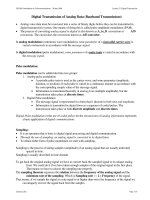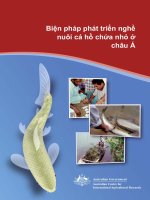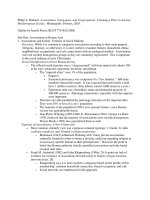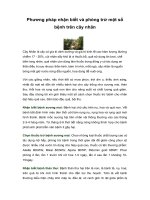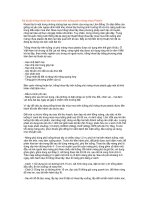Tài liệu ABOVEGROUND CARBON STOCK ESTIMATES OF RUBBER (Hevea brasiliensis) PLANTATION AT MAKILING FOREST RESERVE doc
Bạn đang xem bản rút gọn của tài liệu. Xem và tải ngay bản đầy đủ của tài liệu tại đây (1.91 MB, 30 trang )
* Associate Professor, Institute of Renewable Natural Resources (IRNR), College of Forestry and Natural Resources (CFNR), University of
the Philippines Los Banos
**Assistant Professor, Department of Forestry and Environmental Science, College of Agriculture and Forestry, Bohol Island State
University (BISU), Bilar, Bohol
ABOVEGROUND CARBON STOCK ESTIMATES OF
RUBBER (Hevea brasiliensis) PLANTATION
AT MAKILING FOREST RESERVE
ARTURO SA. CASTILLO* and TOMAS D. REYES, JR.**
INTRODUCTION
Climate change is one of the primary concerns of humanity
today (Lasco et al. 2002).
The World’s forest is shrinking by 0.38% and converted to
other land uses every year.
In fact, according to FAO (2003), 23,260 km
2
of forests are
destroyed per year in Southeast Asia. Problems leading to
poverty rise are even exacerbated by human-aggravated
natural disasters.
Plantations intended, not for timber but, for other purposes
such as fruits and seed sources, and other non-timber
products (one of which is latex production) have valuable role
in relation to climate change.
Similar with the forests, plantations can be sources and sinks
of carbon. Its non-use value, carbon sequestration for
instance, sometimes outweighs natural forests.
Much of the carbon sequestration, according to Lasco and
Pulhin (2003), is attributed to the existence of tree plantations
with a sequestration rate of up to 15 t ha
-1
yr
-1
.
This study was conducted to determine the immense
potential of rubber plantations in sequestering carbon in the
MFR aside from the very purpose of establishing this
plantation for latex and other uses.
Specifically, it provided calculation of the amount of
aboveground (tree) carbon based on recent available
secondary data, and the assessment of the condition of the
site.
A nation-wide study is recommended to determine, quantify
and value the potential environmental-social contributions and
benefits of existing rubber plantations in the Philippines to
mitigate climate change.
METHODOLOGY
Study Site
Rubber (Hevea brasiliensis) plantation in Mt. Makiling was
established in 1961.
Located in Zone 6 of Makiling Forest Reserve (MFR)
14.08 hectares (Almazan et al. 2000), which now totaled to
16 hectares after a series of replanting and expansion
Type 1 climate, annual rainfall ranges from 2,481 to 2,681
mm (MBG Monitoring Station 2000), mean annual
temperature ranges from 25.5 C to 27.5 C.
and Makiling; Clay to silt loam
Topography - slightly rolling to rolling with 10-30% slope.
The area is approximately 199 meters above sea level
and lies in the mid-slope of Mt. Makiling facing the
southeast orientation.
Composed mostly of rubber with 99 other forest tree
species (Almazan et al. 2000)
Biomeasurement and Plantation Assessment
The 14-ha Hevea Plantation of Mt. Makiling Forest
Reserve (MFR) was assessed based on species
composition and forest structure on January 2010–March
2010.
Tree species (together with corresponding
biomeasurements – diameter at breast height, merchantable
height, total height, and others) and understorey vegetation
were recorded down to species level.
In the established 50 (100 sq. meters) plots, a total of 23
species of trees belonging to 19 genera, under 12 families
were identified.
Fifty (50) understorey species in 43 genera and 21 families
were also recorded (Reyes, et al. 2010).
Visual assessment was also conducted to evaluate the
condition of the rubber trees and the whole plantation.
DATA ANALYSIS
Aboveground (Tree) biomasses (in cubic meters and in
tons) were computed using the usual volume computation
formula and of Brown’s (1987) and Brown et al. (1989)
allometric equations
Microsoft Excel was used as the platform in the biomass
and carbon calculation.
Standard volume formula:
Volume (m3) = ∏r
2
*L = ∏(d/2)
2
*L = 0.7854*(DBH in cm)
2
*(MH
in m)
Allometric equations (Brown, 1997 and Brown et al. 1989):
For DBH limit < 60 cm and an annual rainfall ranging from
1,500-4,000 mm (with r
2
= 0.97)
AGB (aboveground biomass) (ton) = exp{-2.134 +
2.530*LN(DBH)}
For DBH limit 60 – 148 cm and an annual rainfall ranging from
1,500-4,000 mm (with r
2
= 0.84)
AGB (ton) = 42.69 – 12.800*(DBH) + 1.242*(DBH)
2
RESULTS AND DISCUSSION
Tree Biomass (in cubic meters)
The tree biomass for the whole plantation was computed
to be 6,486.14 m
3
. This value came from the 231.65 m
3
of
biomass which was calculated from the 50 plots (100 m
2
each) systematically laid in the plantation.
Tree species which contributed much biomass in the
plantation were rubber (Hevea brasiliensis) and mahogany
(Swietenia macrophylla) with 166.40 m
3
(35.92%) and
129.50 m
3
(27.95%), respectively.
Species Common Name
Scientific Name
Density (m
3
/ha)
Rubber
Hevea brasiliensis
166.40
Big-leafed Mahogany
*Swietenia macrophylla
129.47
Igyo
Dysoxylum gaudichaudianum
30.41
Rarang
Erythrina subumbrans
29.50
Palosanto
*Triplaris cumingiana
24.32
Tibig
Ficus nota
13.59
Kalantas
Toona calantas
13.52
Bagtikan
Parashorea malaanonan
9.51
Anubing
Artocarpus ovatus
8.45
Magabuyo
Celtis luzonica
6.25
Ilang-ilang
Cananga odorata
5.43
Amugis
Koordersiodendron pinnatum
4.98
Amuyong
Goniothalamus amuyon
4.42
Banuyo
Wallaceodendron celebicum
4.40
Binuang
Octomeles sumatrana
3.74
Kalomata
Clausena brevistyla
1.82
Kalios
Streblus asper
1.47
Alupag
Litchi chinensis philippinensis
1.41
Dungo
Ficus pubinervis
1.34
Antipolo
Artocarpus blancoi
1.18
Butli
Ficus gul
0.56
Hamindang
Macaranga bicolor
0.34
Aplas
Ficus irisana
0.19
Basikong
Ficus botryocarpa
0.19
Miscellaneous
(unidentified)
0.12
Anuling
Pisonia umbellifera
0.09
Santol
Sandoricum koetjape
0.07
Tuai
Bischofia javanica
0.06
Katap
Trigonostemon acuminatus
0.04
Upling gubat
Ficus ampelas
0.04
Total
463.30
Note: Trees with asterisk (*) are considered invasive – exotic species
Table 1. List of trees and their corresponding volume (m
3
) per hectare
Tree Biomass and Carbon Estimates (in tons)
Estimated total aboveground biomass production for the
whole plantation was 7,030.51 tons. That was about 502.18
tons per hectare.
Its carbon content per hectare basis, following the
conservative estimate of about 45% (Lasco, et al 2003), was
calculated to be 225.98 tons, giving a total carbon of about
3,163.73 tons.
Over thirty-five per cent (35.92%) of the total computed
carbon was attributed to H. brasiliensis trees which
dominated the site (being the desired crop) for almost 4
decades.
Species
Scientific Name
Biomass (ton/ha)
Carbon (ton/ha)
Rubber
Hevea brasiliensis
185.60
83.52
Big-leafed Mahogany
*Swietenia macrophylla
153.23
68.95
Rarang
Erythrina subumbrans
39.74
17.88
Igyo
Dysoxylum gaudichaudianum
25.58
11.51
Palosanto
*Triplaris cumingiana
20.09
9.04
Tibig
Ficus nota
13.03
5.87
Kalantas
Toona calantas
11.56
5.20
Anubing
Artocarpus ovatus
7.42
3.34
Amuyong
Goniothalamus amuyon
6.81
3.07
Bagtikan
Parashorea malaanonan
6.13
2.76
Banuyo
Wallaceodendron celebicum
5.86
2.64
Magabuyo
Celtis luzonica
5.31
2.39
Binuang
Octomeles sumatrana
4.65
2.09
Amugis
Koordersiodendron pinnatum
4.48
2.02
Ilang-ilang
Cananga odorata
4.24
1.91
Kalomata
Clausena brevistyla
1.80
0.81
Alupag
Litchi chinensis philippinensis
1.51
0.68
Kalios
Streblus asper
1.03
0.46
Dungo
Ficus pubinervis
0.94
0.42
Antipolo
Artocarpus blancoi
0.81
0.37
Butli
Ficus gul
0.55
0.25
Basikong
Ficus botryocarpa
0.48
0.22
Hamindang
Macaranga bicolor
0.36
0.16
Aplas
Ficus irisana
0.22
0.10
Anuling
Pisonia umbellifera
0.19
0.08
Miscellaneous
(unidentified)
0.19
0.08
Upling gubat
Ficus ampelas
0.10
0.05
Santol
Sandoricum koetjape
0.10
0.04
Tuai
Bischofia javanica
0.08
0.04
Katap
Trigonostemon acuminatus
0.08
0.04
Table 2. List of tree species with corresponding estimated biomass and carbon content (t ha
-1
)
Note: Trees with asterisk (*) are considered invasive – exotic species.
Rubber plantation plays an important role with regard to
carbon contribution to the environment.
A 27-year old stand of rubber trees in Malaysia had a total
amount of carbon stock of about 319 tC ha
-1
(Sivakumaran et
al 1992 cited by Chung 2004).
In addition, the biomass potential of another 33 year old
stand was recorded to be 444.9 t ha
-1
. This value is close to
those obtained for forest ecosystems in Brazil and Malaysia,
or even higher than those recorded in Thailand and New
Guinea (K. Sivanadyan and Norhayati, 1992 cited by Chung
2004).
The relatively high aboveground (tree) carbon content in
the study site (MFR Rubber Plantation) is due to the fact that
Hevea, and perhaps Swietenia, are very efficient in
converting solar energy into dry matter.
This holds the same observation with the work of Chung
(2004). According to Templeton (1969) cited by Chung
(2004), the rate of dry matter production of 5 ¼ and 6 ¾ years
stand of Hevea was 35.5 tons h
-1
yr
-1
, a relatively high value
among tree species. He also added that at this rate of dry
matter production, the efficiency of utilization of solar
radiation in a stand of Hevea trees with a closed canopy was
calculated to be about 2.8%.
Naimah, Zainol and Yoon (1992) cited by Chung (2004) also
reported that Hevea trees have the highest photosynthetic
productivity and with a capacity to fix 90 million tC yr
-1
.
Though the results above are exceptional case for Hevea
plantation, this estimated aboveground (tree) biomass per
hectare computed was a bit below the estimated biomass of
Swietenia-dominated plantations (Racelis 2000, Lasco et al.
2001), dipterocarps (Racelis 2000), and tree legumes (Lasco
et al 2001) in Mt. Makiling.
This could be because the plantations mentioned were
established a couple of years earlier than the rubber
plantation, and these plantations (especially the first two) are
composed of trees of much bigger stature.
Results of the study further showed that rubber plantation
exhibited lower tree carbon content compared to a natural
forest, a secondary forest, and some fast growing plantations
based on previous studies conducted in the country (Lasco
and Pulhin 2003).
Plantation Assessment
Only about 20.16% of rubber trees was found in good
quality state. Most of them were noted crooked and leaning
(70.93%).
The density of rubber per hectare was computed 258,
while mahogany had 158 individuals. Other tree species
were counted not more than 50 individuals per hectare each.
Huge crown of mahogany also restricted solar radiation to
reach the forest floor which limits the germination of seeds
and the growth of rubber seedlings.
Common
Tree Species
Density
(#/ha)
Tree Form
Crown
Area
(m
2
/ha)
Straight
Forking
Crooked&L
eaning
Hevea
brasiliensis
258
52
(20.16%)
23 (8.91%)
183
(70.93%)
5,065.83
Swietenia
macrophylla
158
83
(52.53%)
28 (17.72%)
47 (29.75%)
4,467.36
Triplaris
cumingiana
42
30
(71.43%)
8 (19.05%)
4 (9.52%)
527.79
Toona calantas
42
12
(28.57%)
7 (16.67%)
23 (54.76%)
824.67
Ficus nota
32
0 (0%)
28 (87.50%)
4 (12.50%)
402.12
Artocarpus
ovatus
24
13
(54.17%)
0 (0%)
11 (45.83%)
301.59
Table 3. Summary of the plantation assessment in the MFR Rubber Plantation
